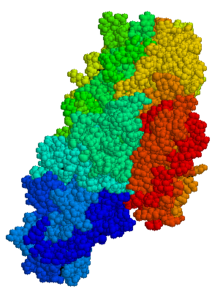Gliadin
| Gliadin/LMW glutenin | |
|---|---|
| Identifiers | |
| Symbol | Glia_glutenin |
| InterPro | IPR001954 |
| Gliadin [Seed storage proteins] N-terminal helical domain | |||||||||
|---|---|---|---|---|---|---|---|---|---|
| Identifiers | |||||||||
| Symbol | Gliadin | ||||||||
| Pfam | PF13016 | ||||||||
| InterPro | IPR016140 | ||||||||
| |||||||||

Gliadin (a type of
Both gliadins and glutenins are not
Gliadin can cross the intestinal epithelium. Breast milk of healthy human mothers who eat gluten-containing foods presents high levels of non-degraded gliadin.[2][3]
Types
The α, γ, and ω gliadin types are separated and distinguished based on their amino acid sequences in the N-terminal cysteine domain.[4][5]
- α-/β-gliadins – soluble in low-percentage alcohols.
- γ-gliadins – ancestral form of cysteine-rich gliadin with only intrachain disulfide bridges[6]
- ω-gliadins – soluble in higher percentages, 30–50% acidic acetonitrile.
Chemistry
The gliadins are intrinsically disordered proteins meaning that they have continuously altering shapes making it difficult to study them. The performed image analysis and computer simulations of the proteins show that the average shape of the gliadins follows an elliptical shape.[7] More specifically does the protein likely have a tad-pole like structure with a hydrophobic core and a loose disordered tail.[8] Compared to the other gluten proteins like the glutenins, which form extended networks of polymers due to disulphide bonds, gliadins are monomeric molecules in the cell, even if they in many ways are very similar. Especially the low molecular weight glutenins are similar in the way that they have cysteines located in matching locations as many of the gliadins. However, the gliadins are unable to form polymers in the cell since its cysteines form intra-chain disulphide bonds at synthesis due to hydrophobic interactions.[7]
Gliadins are capable to aggregate into larger oligomers and interact with other gluten proteins, due to large hydrophobic sections, poly-Q and repetative sequences. These sections are likely to aggregate hydrophobicaly, liquid-liquid phase separate, potentially form β-sheets aggregates or simply entagles by its structural properties.[8][9]
Biochemistry
Gliadins are prolamins and are separated on the basis of electrophoretic mobility and isoelectric focusing. Gliadin peptides cross the intestinal barrier by active transport. [citation needed]
Metabolism
Gliadins are known for their role, along with glutenin, in the formation of

Gliadin can also serve as a useful delivery method for sensitive
For useful description of the gliadins see:
Deamidated gliadin
Deamidated gliadin is produced by acid or enzymatic treatment of gluten. The enzyme tissue transglutaminase converts some of the abundant glutamines to glutamic acid. This is done because gliadins are soluble in alcohol and cannot be mixed with other foods (like milk) without changing the foods' qualities. Deamidated gliadin is soluble in water. The cellular immunity to deamidated α-/β-gliadin is much greater than α/β-gliadin and can result in symptomatic gluten-sensitive enteropathy.[citation needed]
Celiac disease
The main problem with this disease is that it often goes unrecognized for many years, in which case it can cause serious damage to several organs,
The only available treatment for celiac disease is a strict gluten-free diet in which the affected person does not ingest any gluten-containing products. There have been searches for an affordable and much better treatment, but the only treatment remains to abstain from ingesting any gluten.[13]
See also
- Anti-gliadin antibodies
- Gluten immunochemistry
- Glutenin
- Non-celiac gluten sensitivity
- Gluten-related disorders
- Intestinal permeability
References
- PMID 24032428.
- PMID 18425213.
- PMID 9867098.
- ^ CID 17787981 from PubChem
- PMID 28385663.
- PMID 19383144.
- ^ PMID 32717949.
- ^ a b Markgren J (2022). "Aggregation of gluten proteins - from wheat seed biology to hydrogels : scientific modelling based primarily on Monte-Carlo and HPLC methods". pub.epsilon.slu.se. Retrieved 2022-06-10.
- S2CID 248805639.
- S2CID 10259661.
- ^ PMID 16313685.
- PMID 15932501.
- ^ PMID 25922674.
- ^ PMID 16214317.
- ^ S2CID 24533103.
- PMID 26060103.
- ^ PMID 15825129.
- PMID 26109797.
- S2CID 2023530.
- PMID 26438584.
External links
- Gliadin at the U.S. National Library of Medicine Medical Subject Headings (MeSH)
